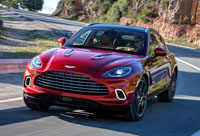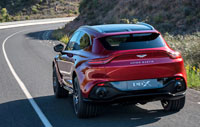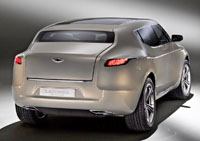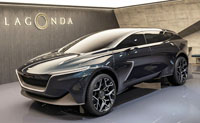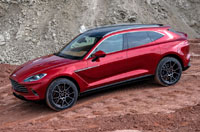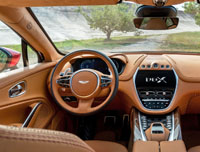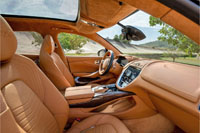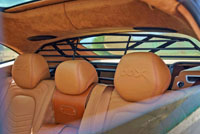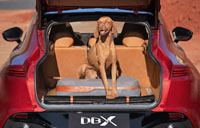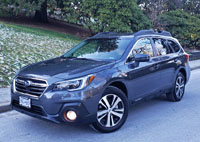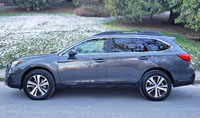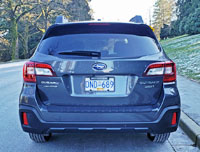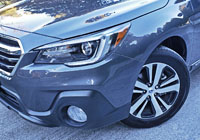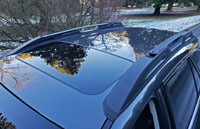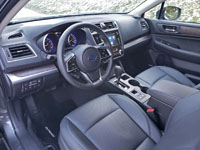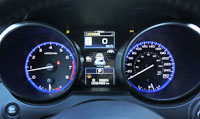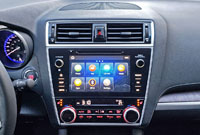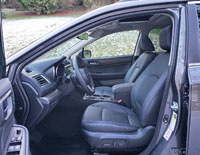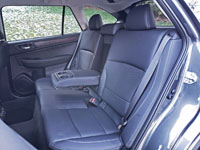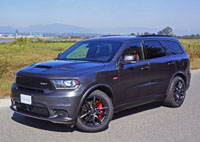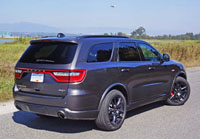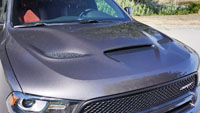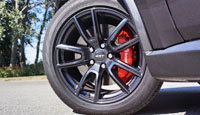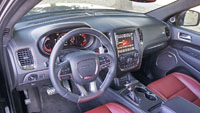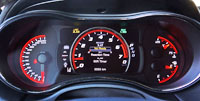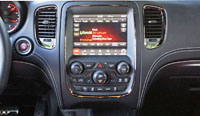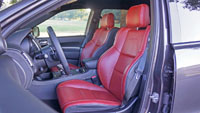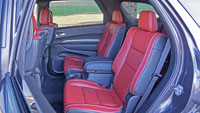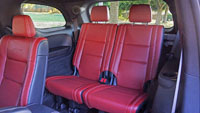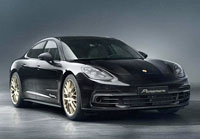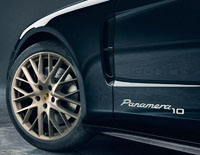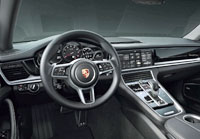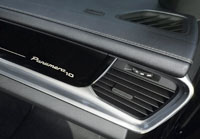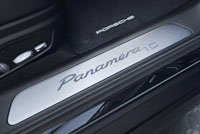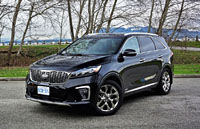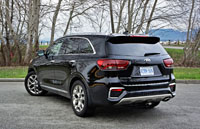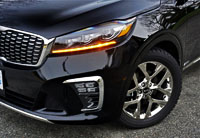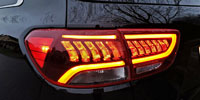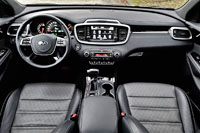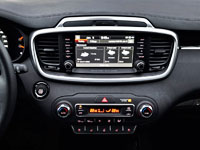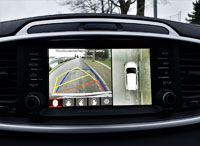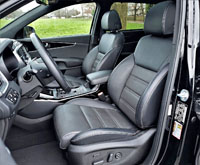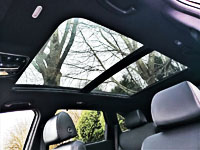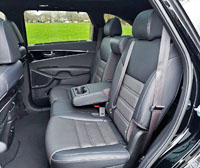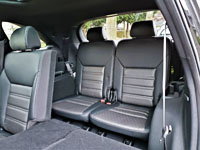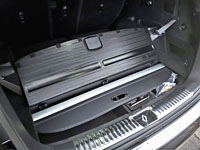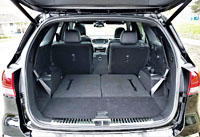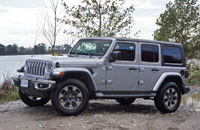
Jeep redesigned its popular Wrangler 4×4 for 2018, so as is usually the case for the following model year this 2019 variant remains unchanged, although the upcoming 2020 model will get a significant powertrain upgrade that may cause some who’ve never considered it before to reconsider. Interested? Keep reading.
Jeep produced the Wrangler’s JK body style from 2007 to 2017, and it’s been one of the most successful models in the entire Chrysler/FCA group since then. Now, the new 2018 to present JL version features a bigger, bolder, broader seven-slot grille, plus new optional LED reflector headlights, an ATV-like front bumper (which looks a lot like the one used for the 2016 Wrangler 75th Anniversary Edition I covered way back then) with optional LED fog lights, a shapelier hood (although not pumped up with the Anniversary Edition’s muscular power dome and blackened vents or the Rubicon’s similarly awesome hood design), restyled front fenders with new wraparound turn signals, heavily sculpted front body panels with black engine vents, new integrated side steps, fresh new rear fender flares, new wraparound taillights with optional LEDs, a new side-swinging tailgate, and a redesigned rear bumper (that’s not as cool looking as 75th Anniversary Edition’s, but definitely more attractive than the block of metal and black plastic found on the old Sahara).
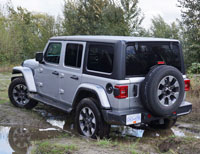
While those not following everything Jeep may want to park a new JL next to the old JK in order to see the subtler differences, such as the just-noted redesigned tailgate, it’s reasonable to surmise that most of the new Wrangler’s exterior panels have been changed in order to accommodate its longer regular and long Unlimited wheelbases. Specifically, the 2019 Unlimited on this page is 89 mm (3.5 inches) longer than the old JK model, with a 61-mm (2.4-inch) longer wheelbase, while the regular wheelbase version grows in length as well. Overall, the new Wrangler appears classic and contemporary simultaneously, and even more important, it looks good.
Also critical, the new Wrangler is considerably more refined inside, with doors that shut with a solid thunk, and pliable soft-touch composite surfaces used most everywhere above the waste. The dash top and instrument panel even use some padded and contrast-stitched leatherette that matches the leather-clad steering wheel rim, plus the leatherette shifter boot and armrests, and the genuine leather seat upholstery. All the buttons, knobs and switches used through the cabin are impressive too, specifically the big audio volume and dual-zone automatic climate control knobs on the centre stack, while Jeep has improved the general quality of most materials as well as the way everything fits together.
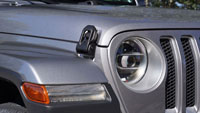
As good as all of these changes are, the Wrangler’s gauge cluster might generate the cabin’s biggest wow factor. First, let’s be clear that it’s not a fully digital instrument panel, which would’ve probably been easier and less expensive to create, considering how two-dimensionally flat the previous four-gauge design was, and how easy it would’ve been to merely install a 12.3-inch display, fill it with graphics (not that this is simple) and call it a day. Instead, Jeep shaped two motorcycle-style individually hooded primary dials, bookended by a large colour multi-information display (MID). It looks great, and provides most of the digital tech today’s buyers are looking for, even including army green background graphics highlighted by a WW2 (Willys) GP. The tach and speedometer dials look superb in their orange on black and white design, and everything functions well.
The outgoing 6.5-inch rectangular centre touchscreen has also been replaced, but this time with a fully digital design incorporating no buttons or knobs at either side of the display. Instead, the new 8.0-inch square touchscreen offers some quick-access analogue switchgear on a cluster of dials and buttons positioned underneath, these used mostly for controlling heating and ventilation. The big dial on the very right is for scrolling or browsing through infotainment functions, and while some might find this useful I mostly tapped, swiped and pinched the touchscreen as required (sounds more exciting than it was), only making use of external controls for heating the seats and steering wheel (although you can do this via the touchscreen too), adjusting cabin temperatures (ditto), and the audio system’s volume.
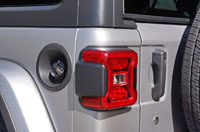
The bigger display area results in a much better backup camera, which once again uses active guidelines for slotting into parking spaces, while the ability to hook up Android Auto or Apple CarPlay is a bonus. The system incorporates most other functions available these days, like accurate navigation, easy phone setup and use, audio selection that includes satellite radio and wireless streaming, and a number of apps that come preloaded or can be downloaded. The display’s resolution is quite good, but it’s not as crisp and clear as you’ll find in the majority of premium brands, and a few new mainstream competitors like Chevrolet’s Blazer.
The car-based Blazer in mind, the new Wrangler delivers its best ride quality yet. In fact, it’s now something I’d brag about, rather than complain of while rubbing the small of back and nether regions. To be clear, the JK I tested on its initial 2005 Lake Tahoe/Rubicon Trail press launch showed major ride and handling improvements when compared to its 1997 to 2006 TJ predecessor, while that SUV was wholly more comfortable than the 1987 to 1995 YJ, and so on with respect to the many CJs (Civilian Jeeps) that came before (I used to drive a V8-powered CJ5 Renegade in the early ‘80s), but this new JL-bodied Wrangler is so much nicer to live with than any of its forebears that I’d now consider owning one, something I still wouldn’t have said about the JK. The reality is I’m aging, and therefore wouldn’t be willing to be discomforted by my daily commuter. The new Wrangler, however, completely changes everything with suspension compliancy that’s matched by much-improved cornering capability, better high-speed tracking, easier manoeuvrability around town and in tight parking lots, etc. All around, this Wrangler is a much, much better SUV to live with.
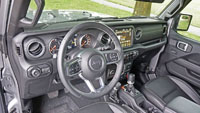
This new livability includes improved rear seating, with deeper sculpted outboard positions that offer up more lower back support, while the increased wheelbase provides more second-row legroom. Three passengers continue to fit across the rear seat, although I’m going to guess only smaller folks will truly be comfortable in the middle. Also, with only two in back the centre folding armrest, incorporating two big rubberized cupholders and a personal device holder, can be lowered for even more comfort and convenience.
This said, not hollowing out a section behind that armrest for a rear-seat pass-through was an opportunity missed by Jeep, because now you’ll need to expend money for a lockable rooftop compartment for stowing longer items such as skis and snowboards, if you want two rear passengers to enjoy as much comfort as possible. This is doable, but it’s not the best solution, although this is also true for the majority of Jeep competitors.
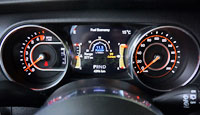
Another complaint is the Wrangler’s swinging rear door, which remains hinged on the wrong side for North American, and most global markets. A conventional liftgate is out of the question for two reasons, 1) the removable roof, and 2) the 4×4 requirement of a full-size spare tire on its backside. What’s not required is a set of hinges on the passenger side, which means that loading the rear cargo compartment from curbside becomes awkward at best, potentially causing you to step in traffic to do so. Me complaining about this issue won’t be anything new to regular readers or those in charge of Jeep (that are listening), but it may be important to newbies considering a Wrangler for the first time.
A more positive cargo compartment issue is increased volume, the long-wheelbase Unlimited’s dedicated luggage area now increased by 18 litres (0.6 cubic feet) to 898 litres (31.7 cu ft), while maximum capacity has grown by 70 litres (2.5 cu ft) to a new grand total of 2,050 litres (72.4 cu ft) with both seatbacks laid flat. Laid flat is probably a misrepresentation, however, as there’s now an incline from the base of the seatbacks to the front portion of the extended cargo area, although another positive is the ease in which they’re now lowered, plus new panels that hide the previously exposed seat frames and other mechanical bits when laid down. These panels stop smaller items from rolling below, but these conveniences have been taken for granted by crossover SUV owners for years. Still, it’s a serious upgrade for the Wrangler, and, in my opinion, well worth the slightly uneven load floor.
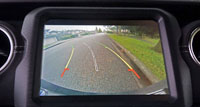
At the other end of my 2019 Wrangler Unlimited Sahara tester was FCA’s 3.6-litre Pentastar V6, conjoined to an eight-speed automatic transmission and part-time four-wheel drive. While not quite as sonorous as my old CJ5’s 304 cubic-inch V8 (that included a rather loud set of aftermarket headers), the V6 produces a nice soundtrack of its own, and provides plenty of forward energy thanks to 285 horsepower and 260 lb-ft of torque, while the automatic transmission’s shift increments are quick and smooth.
A six-speed manual comes standard, incidentally, with the eight-speed auto tacking $1,595 onto the 2019 Wrangler Unlimited Sport S’ $40,745 (plus freight and fees) price tag, while this Unlimited Sahara starts at $44,745, and the top-line Unlimited Rubicon can be had for a retail price of $47,745 (a base two-door Wrangler S starts at $33,695). Alternatively, Wrangler buyers can pay $2,590 for a 2.0-litre turbocharged four-cylinder engine featuring electric assist, which makes 15 horsepower less at 270, although 35 lb-ft of torque more at 295. This upgrade is standard with the eight-speed automatic, and is claimed to achieve much better fuel economy than the V6 (see all 2018, 2019 and 2020 Jeep Wrangler prices, including trims, packages and individual options, plus manufacturer rebates and dealer invoice pricing right here on CarCostCanada, where you can now save up to $3,500 in additional incentives on a 2020, or $4,000 on a 2019).
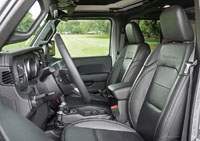
By the numbers, the base Wrangler Unlimited’s V6 and six-speed manual combo is rated at 13.8 L/100km city, 10.1 highway and 12.2 combined, whereas the same engine with the eight-speed auto uses a claimed 12.9 city, 10.2 highway and 11.7 combined. As for the four-cylinder turbo, its 10.9 city, 10.0 highway and 10.5 combined rating is by far the best right now, but it may only hold this title for a short duration as the upcoming 2020 Wrangler will soon offer FCA’s ultra-efficient 3.0-litre V6 turbo-diesel, while it will hardly be short on output thanks to 260 horsepower and 442 pound-feet of torque. I can imagine the Wrangler’s many dedicated 4×4 fans salivating at the prospect of this engine right now, diesels long being optimal off-road, but take note it will only be available in the long-wheelbase Unlimited body, while the more off-pavement capable regular-wheelbase Wrangler will continue to only be powered by gasoline engines.
Off-roading in mind, today’s more refined Wrangler still has few direct competitors. In fact, pickup trucks aside, the Wrangler is the only serious off-roader available in the mainstream volume-branded compact class, and will likely remain so until the all-new Ford Bronco arrives on the scene. The General’s compact pickup-based Chevy Blazer and GMC Jimmy duo was killed off in 2005, while Toyota’s Land Cruiser Prado-based FJ Cruiser hightailed it out of our market in 2014. Following suit, the very capable Nissan Xterra departed in 2015, leaving the popular Wrangler alone in its unique segment.
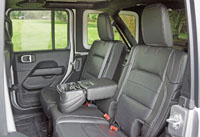
As is only right, I tested the Wrangler Unlimited Sahara at a favourite 4×4 haunt and it performed as ideally as you might expect. In fact, all the thick mud and big pools of standing water were easy for this capable utility to muck and wade through, making me wonder if the ultra-rugged Rubicon is more than most Wrangler buyers require. Once off-pavement I slotted the secondary low gear lever into its 4H Part Time position to tackle the semi-rough stuff, which provided quick travel over less challenging terrain.
Diving deep into the big puddles and digging into some of the more abyss-like ruts caused me to stop and engage 4L (four-low), however, which made traversing all of the truly difficult terrain a breeze as well. While a decent test track considering its close proximity to my home, I’ve driven the old JK on the Rubicon Trail and other difficult courses and enjoyed both the challenge of negotiating trails I’d likely never try on my own, and doing so in such an amazingly agile 4×4, while I can only imagine how much more enjoyable it would be to scale Cadillac Hill atop the new Wrangler’s improved suspension, let alone doing so while being pushed via a turbo-diesel V6.
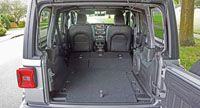
If all the improvements already mentioned aren’t enough to get you into the driver’s seat of a new Wrangler, this SUV makes smart business sense too. According to ALG, the Wrangler has the highest residual value of any model in Canada, with the four-door Unlimited version only dropping by an average of 30-percent after three years of use, and the two-door model only losing 31.5 percent. What’s more, the Wrangler also earned the Canadian Black Book’s 2019 Best Retained Value Award in the Compact SUV category for the ninth year in a row, while it achieved a new retained value record of 91 percent for 2019 (Jeep’s smaller car-based Renegade placed first in its Sub-Compact Crossover segment too).
What this means for those still sitting on the fence, is that Jeep’s Wrangler no longer needs any justification. It’s about having your cake and eating it too, or in other words getting what you want and making the smartest choice simultaneously. Don’t you wish all decisions were so easy?
Story and photo credits: Trevor Hofmann

